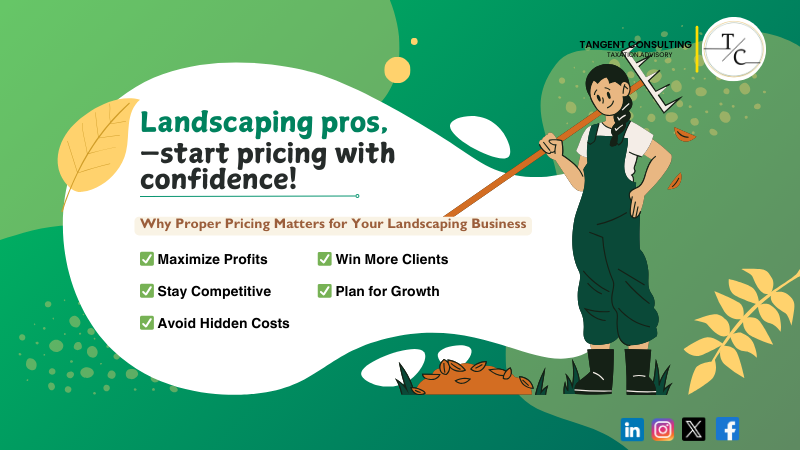Here’s How to Price Landscaping Jobs in 5 Steps
Here’s How to Price Landscaping Jobs in 5 Steps

Have you ever bought one of those fancy lattes that cost like seven bucks? You take a sip, and you consider your life choices. Was it that good that you were willing to spend $7 on it?
We don’t know about you, but we love coffee, so we are in the $7 camp.
Unlike spending on coffee, you have to be mindful of some things, including your business. Imagine you are a landscaping business owner, and you underprice your work. You can lose a significant sum.
The problem is that pricing landscaping jobs can be tricky. If you charge too much, clients may be hesitant to sign up, and if you charge too little, you can lose significant profit.
However, there’s a way around this.
In this guide, we’ll break down how to price landscaping jobs in 5 steps and present some of the best practices you can apply for pricing jobs. So, make sure to stick till the end.

Before You Begin
Before diving into your estimate, start with a conversation. You need to talk to the client, ask questions, and, most importantly—find out their budget. This helps you figure out if the job is worth your time and if it’s a good fit for your business.
Next, visit the job site yourself. Walk around, take measurements, and check for any issues that might come up during the project. You might even spot some upsell opportunities to suggest to the client.
Now, make a game plan. Think about the materials, subcontractors, and extra labor you’ll need to get the job done.
Keep in mind that hardscaping (like walls and walkways) will cost more since it requires additional work and materials.
Here are a few key factors to consider when pricing a landscaping job:
- The client’s preferred style (Japanese, modern, tropical, etc.)
- Features they want, like a stone pathway
- Types of plants and materials required
- Location—will it be difficult to access?
- Soil quality
- Condition of the yard (Is it a blank slate or a major cleanup?)
If you want a detailed price breakdown for the lawn mowing business, check out our guide here.

How to Price Landscaping Jobs?
Ok, now let’s move on to the juiciest part of the guide: how to price landscaping jobs in five steps.
1. Calculate Overhead Costs
Pricing landscaping jobs correctly means covering all your costs—including overhead. That includes:
- Vehicle expenses
- Advertising
- Office rent
- Equipment repair and maintenance
- Tools and uniforms
- Accountant and legal fees
- Internet and phone bills
- Business Insurance
Many small business owners underestimate their overhead, which can cut profits—even if they charge a markup.
According to Green Industry Pros, at least 20% of a landscaping contractor’s revenue goes toward overhead costs.
Instead of guessing, divide your weekly overhead cost by the average hours you work per week, and add that number to your job estimate.

2. Calculate Material Costs
Since you’ve already created a plan, figuring out material costs should be straightforward. Go through the list of materials and confirm if the client is providing anything—if so, remove it from your estimate.
Here are some common landscaping materials to account for:
- Compost
- Cement
- Lawn seed
- Trees, plants, and other greenery
- Mulch
- Patio pavers
- Lawn treatments
- Gravel, boulders, and floodlights
- Equipment rentals
Use your job site measurements to estimate how much you’ll need. Once you have your total, add it to your project cost. You can also use a free landscaping cost calculator to estimate more accurately.
3. Calculate Subcontractor Costs
This step is easy—just send your project details to your subcontractors and ask for a quote. Once you get their price, add it to your total job cost.
4. Calculate Time and Labor Costs
To estimate how long a job will take, look at similar projects you’ve done before. If this is a new type of project, ask colleagues or subcontractors for insight. Tracking time on past projects can also help fine-tune future estimates.
Once you have a time estimate, calculate labor costs:
- If you’re working on the project yourself, include your hourly rate.
- If you have employees, estimate their total labor cost.
Wondering what to pay your workers?
According to the Bureau of Labor Statistics, the median hourly wage for landscaping workers is $17.96, ranging from $13.98 to $24.96, depending on location.
Also, don’t forget payroll taxes (FICA). A safe estimate is to add 18% extra to your total labor cost.

5. Add Your Markup
Overhead costs are separate from markup. Your markup is what ensures profit after covering expenses.
If you have a strong track record and happy clients, consider raising your rates. Just be sure to check your competitors’ prices so you stay competitive.
Pricing Tips and Best Practices
Guarantee Competitive Pricing
To stay competitive, compare your rates with other landscaping businesses in your area:
- Check competitor pricing—look at websites, call for quotes, or ask industry peers.
- Know your market—urban areas usually have higher prices than rural ones.
- Charge based on value, not just price. Offer premium services like fast turnaround or high-quality materials, and price accordingly.
Finding the balance between competitive pricing and profitability ensures you attract clients while keeping your business healthy.

Keep Track of Inflation
Prices don’t stay the same forever—labor, materials, and overhead costs rise over time. To stay ahead, review your pricing every few months and adjust for inflation.
A simple strategy is to increase your rates slightly each year to cover rising costs. This keeps your business profitable without shocking your clients with big price jumps.
Final Thoughts
So, now you know how to price landscaping jobs. You’re ready to create an accurate, competitive, and profitable landscaping estimate.
Of course, every project is different, and the more experience you gain, the better you’ll get at pricing jobs. But one thing’s for sure: running a landscaping business means more than just cutting grass and planting flowers.
And keeping up with accounting can be a pain. If you’d rather focus on landscaping instead of bookkeeping, let’s take the burden off your shoulders.
Tangent Consulting is your go-to source for outsourcing your accounting department. We can help you prevent cash flow leaks by understanding your business. So, you don’t sleep worrying about your business accounting.
P.S. If you are reading this, it means you can have access to our free consultation for your business. Avail this for free today before we change our mind.
FAQs
How do you calculate profit for a subcontractor job?
You need to take the total amount you’re getting paid, subtract your material, labor, and overhead costs, and then add your markup. The leftover amount is your profit.
How to price a freelance landscape design?
You can charge based on time and expertise—factor in hourly rates, project complexity, and revisions. Many designers charge a flat fee per square foot, typically $50–$150/hour.
What is the cost of starting a small landscaping business?
Startup costs vary, but you’ll need at least $5,000–$15,000 for equipment, licensing, insurance, and marketing. If you’re starting small, you can begin with just a few thousand.
